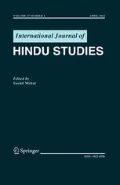Abstract
Why do four birds narrate the Mārkaṇḍeya Purāṇa? Narrative enframement plays a crucial role in contextualizing Sanskrit literature. The narrative frame of the Mārkaṇḍeya Purāṇa exhibits acute awareness of the framing of the Mahābhārata. The Purāṇa’s Birds are in fact direct descendants of the Śārṅgakas escaping devastation at the cataclysmic burning of the Khāṇḍava Forest. This hair-raising episode serves as the monumental terminal frame of the Ādi Parvan, which, as the epic’s Book of Beginnings, itself serves as inaugural frame for the epic as a whole. The Śārṅgaka account is therefore laden with themes pervading the epic, themes upon which the Mārkaṇḍeya Purāṇa Birds brilliantly comment. The Birds themselves partake in an even more involved intertextual device: they are deployed to address four questions which inaugurate the Mārkaṇḍeya Purāṇa, questions about the content of the Mahābhārata. This article examines the clever manner in which the Mārkaṇḍeya Purāṇa’s opening frame intertextually harkens to the Mahābhārata’s Śārṅgaka episode, engaging the epic’s avian artistry through its own. Building on the work of Alf Hiltebeitel and Simon Brodbeck, this article reexamines the Śārṅgaka episode in light of the story of Śṛṅgin, demonstrating that the Mārkaṇḍeya Purāṇa avian frame responds to a core riddle proper to the epic’s own masterful enframement, one dramatized in the plight of the Śārṅgakas. The Mārkaṇḍeya Purāṇa thereby not only demonstrates a sophisticated cultural literacy when it comes to Sanskrit narrative, but it also leverages that literary legacy to execute its own ideological agenda, invoking India’s great epic all the while.
Similar content being viewed by others
References
Adluri, Vishwa P. 2011. “Frame Narratives and Forked Beginnings: Or, How to Read the Ādiparvan.” Journal of Vaishnava Studies 19, 2: 143–210.
Balkaran, Raj. 2017. “The Essence of Avatāra: Probing Preservation in the Mārkaṇḍeya Purāṇa.” Journal of Vaishnava Studies 26, 1: 25–36.
Balkaran, Raj. 2019a. The Goddess and the King in Indian Myth: Ring Composition, Royal Power, and the Dharmic Double Helix. New York: Routledge.
Balkaran, Raj. 2019b. “Visions and Revisions of the Hindu Goddess: Sound, Structure, and Artful Ambivalence in the Devī Māhātmya.” Religions 10, 5: 322.
Balkaran, Raj. 2020. The Goddess and the Sun in Indian Myth: Power, Preservation and Mirrored Māhātmyas in the Mārkaṇḍeya Purāṇa. New York: Routledge.
Banerjea, K. M., ed. 1855. The Márcandeya Purána. Calcutta: Bishop’s College Press.
Brodbeck, Simon Pearse. 2009. The Mahābhārata Patriline: Gender, Culture and the Royal Hereditary. Burlington: Ashgate Publishing.
Brodbeck, Simon, trans. 2019. Krishna’s Lineage: The Harivamsha of Vyāsa’s Mahābhārata. New York: Oxford University Press.
Brodbeck, Simon and Brian Black. 2007. “Introduction.” In Simon Brodbeck and Brian Black, eds., Gender and Narrative in the Mahābhārata, 1–34. New York: Routledge.
Buitenen, J. A. B. van, trans. and ed. 1973. The Mahābhārata. Volume 1: Book 1: The Book of the Beginning. Chicago: University of Chicago Press.
Dutt, Manmatha Nath, ed. 1896. A Prose English Translation of Markandeya Puranam. Calcutta: Elysium.
Eco, Umberto. 1994. Six Walks in the Fictional Woods. Cambridge: Harvard University Press.
Hiltebeitel, Alf. 1976. “The Burning of the Forest Myth.” In Bardwell L. Smith, ed., Hinduism: New Essays in the History of Religions, 208–24. Leiden: E. J. Brill.
Hiltebeiltel, Alf. 1999. “Reconsidering Bhṛguization.” In Mary Brockington and Peter Schreiner, eds., Composing a Tradition: Concepts, Techniques and Relationships, 155–68. Zagreb: Croatian Academy of Sciences and Arts.
Hiltebeitel, Alf. 2005. “Not Without Subtales: Telling Laws and Truths in the Sanskrit Epics.” Journal of Indian Philosophy 33, 4: 455–511.
Hiltebeitel, Alf. 2007. “Among Friends: Marriage, Women, and Some Little Birds.” In Simon Brodbeck and Brian Black, eds., Gender and Narrative in the Mahābhārata, 110–43. New York: Routledge.
Minkowski, Christopher Z. 1991. “Snakes, Sattras, and the Mahābhārata.” In Arvind Sharma, ed., Essays in the Mahābhārata, 384–400. Leiden: Brill.
Monier-Williams, Monier. 2006 [1899]. A Sanskrit-English Dictionary. Oxford: Clarendon Press.
Pargiter, F. Eden, trans. 1904. The Mārkaṇḍeya Purāṇa. Calcutta: The Asiatic Society of Bengal.
Pilikian, Vaughan, ed. and trans. 2006. Mahābhārata. Book Seven: Droṇa. Volume 1 of 4. New York: New York University Press.
Smith, John D, trans. 2009. The Mahābhārata. New Delhi: Penguin Books.
Author information
Authors and Affiliations
Corresponding author
Additional information
Publisher's Note
Springer Nature remains neutral with regard to jurisdictional claims in published maps and institutional affiliations.
Rights and permissions
About this article
Cite this article
Balkaran, R. Avian Artistry: Decoding the Intertextuality Between Mahābhārata and Mārkaṇḍeya Purāṇa. Hindu Studies 24, 199–237 (2020). https://doi.org/10.1007/s11407-020-09277-1
Published:
Issue Date:
DOI: https://doi.org/10.1007/s11407-020-09277-1




